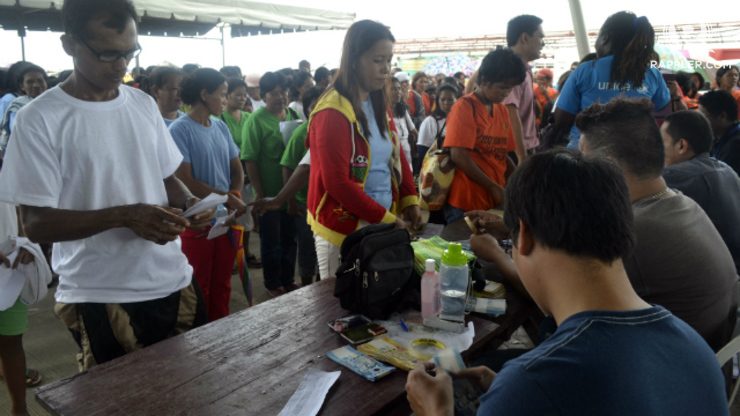SUMMARY
This is AI generated summarization, which may have errors. For context, always refer to the full article.

MANILA, Philippines – When Filipinos are asked to describe their financial status, whether based on income or purchasing power, 3 terms are usually heard: mayaman (rich), may kaya (well-off), and mahirap (poor).
The boundaries of each classification are often blurry. Arguments have emerged over when one can be considered rich or middle class. In most cases, those belonging to the poor sector are the easiest to identify, since a total poverty threshold (TPT) is set by the government.
But according to the Department of Social Welfare and Development (DSWD), it is very important to also identify those who are just a step away from poverty.
“In ending poverty, we should not only target those living already in poverty but also people who are already at risk of becoming poor,” Social Welfare Secretary Corazon Soliman emphasized.
Near-poor
In a forum organized by the DSWD, the Philippine Statistics Authority, and the Asian Development Bank on Tuesday, October 7, the Philippine Institute of Development Studies (PIDS) presented a study that defined those on the brink of poverty.
The study, entitled, “Analysis of the Near-Poor Challenge and Strategy Development Ideas,” sought to distinguish the lower-half of the sector not classified as poor. It also recommended how they can be prevented from completely falling into the poverty trap.
According to Dr Vicente B. Paqueo of PIDS, the primary concern behind the study is the increasing number of households above the poverty line that have a high risk of falling into poverty.
Near-poor are households at risk of becoming poor or are on the edge, just above the TPT. The proposed near-poor threshold (NPT) is 1.28% above the TPT.
Given that the official TPT in the Philippines is currently at P9,686 ($216*), the NPT would be around P12,400 ($277).
Meanwhile, those households above the TPT but below the NPT have a 50% probability of becoming poor again.
According to the study, the households considered near-poor have enough assets that contribute to meeting the basic needs of the family. So when a problem arises that may diminish their assets, such as a health problem, this will result in inability to obtain the basic necessities.
Other characteristics of a near-poor household are:
- Of small family size
- Mostly headed by a male
- Household head is educated
- Mostly non-agricultural workers
- More unemployed
- Have access to electricity
- Have own house and lot made of strong materials
Why study?
Data gathered from 2004 to 2010 of the Annual Poverty Indicator Survey (APIS) showed that 38.6% of total households in the Philippines are cyclical poor, while those that are persistently poor are at 8%. Also called balik-balik, cyclical poor are families in and out of poverty for a given period of time.
By classifying households in the Philippines, government programs can respond to the needs of each sector, instead of a uniform type of assistance for all sectors. (READ: Community-level approach: Answer to PH poverty?)
“If you are able to group households or rank them based on their poverty risk, you can make better and target-driven programs,” Paqueo said.
The near-poor, according to him, are easier to prevent from falling back to poverty. Nonetheless, the concerned agencies should promote a “win-win situation.”
“Best thing to do is we find measures and ways to serve the near-poor and poor,” Paqueo emphasized.
Empowering the near-poor
The study recommended that to assist those in the near-poor sector, government reforms are necessary. Paqueo cited as an area of reform the minimum wage law which, he said, discriminates against women, the young, inexperienced, and the poor.
Another recommendation is funding and implementation of public infrastructure such as farm-to-market roads, flood control measures, health facilities, and school buildings as these will contribute to maximizing the assets of households.
Finally, the government should develop a social assistance program that will target the near-poor – much like what the Pantawid Pamilyang Pilipino Program (4Ps) is doing. The essence of this, according to the study, is to bank on the savings of the near-poor which they can use as capital for livelihood.
If these plans to assist the near-poor will become a reality, it is estimated to cost P6 billion ($134 million)*, almost 10% of the total 2014 4Ps of P62 billion ($1.38 billion).
Evidence-based gov’t programs
Near-poor households will be screened and identified by DSWD’s National Household Targeting System for Poverty Reduction (NHTS-PR).
The program, also called Listahanan, is an information management system that identifies details of those in need in the Philippines.
Soliman believes that by pursuing this study, the government can employ a cost-effective poverty alleviation program.
“Evidence-based policy-making should be a reality,” the DSWD chief emphasized. “We’ve been working on eradicating poverty but if we consistently use data as basis of policies, we would become more effective.”
Meanwhile, DSWD Undersecretary Florita Villar is confident that implementing the recommendations of the study will help ensure that no sector in the country will be left out.
“Unless we have these data, we cannot justify programs that will target the near-poor. We should not wait for them to become poor before we provide assistance,” Villar said. – Rappler.com
*$1 = P44.7
Add a comment
How does this make you feel?
There are no comments yet. Add your comment to start the conversation.